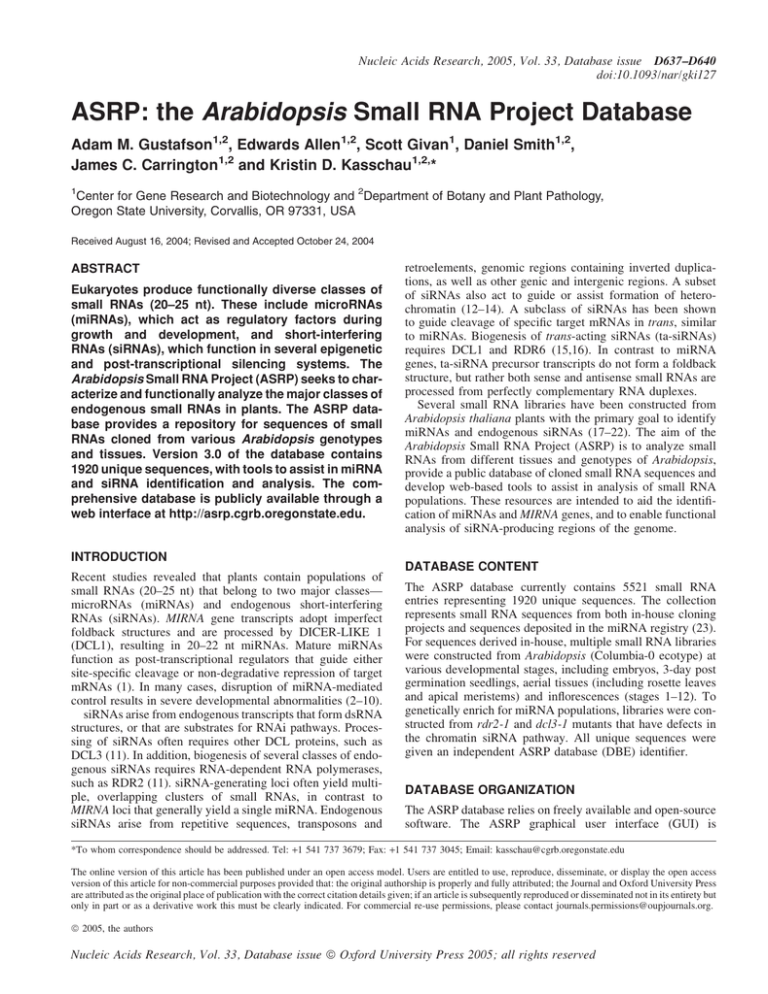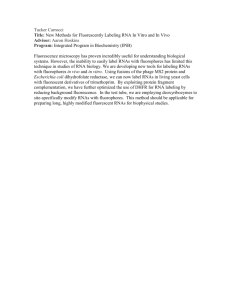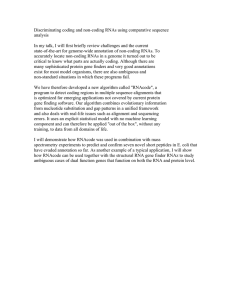
Nucleic Acids Research, 2005, Vol. 33, Database issue D637–D640
doi:10.1093/nar/gki127
ASRP: the Arabidopsis Small RNA Project Database
Adam M. Gustafson1,2, Edwards Allen1,2, Scott Givan1, Daniel Smith1,2,
James C. Carrington1,2 and Kristin D. Kasschau1,2,*
1
Center for Gene Research and Biotechnology and 2Department of Botany and Plant Pathology,
Oregon State University, Corvallis, OR 97331, USA
Received August 16, 2004; Revised and Accepted October 24, 2004
ABSTRACT
Eukaryotes produce functionally diverse classes of
small RNAs (20–25 nt). These include microRNAs
(miRNAs), which act as regulatory factors during
growth and development, and short-interfering
RNAs (siRNAs), which function in several epigenetic
and post-transcriptional silencing systems. The
Arabidopsis Small RNA Project (ASRP) seeks to characterize and functionally analyze the major classes of
endogenous small RNAs in plants. The ASRP database provides a repository for sequences of small
RNAs cloned from various Arabidopsis genotypes
and tissues. Version 3.0 of the database contains
1920 unique sequences, with tools to assist in miRNA
and siRNA identification and analysis. The comprehensive database is publicly available through a
web interface at http://asrp.cgrb.oregonstate.edu.
INTRODUCTION
Recent studies revealed that plants contain populations of
small RNAs (20–25 nt) that belong to two major classes—
microRNAs (miRNAs) and endogenous short-interfering
RNAs (siRNAs). MIRNA gene transcripts adopt imperfect
foldback structures and are processed by DICER-LIKE 1
(DCL1), resulting in 20–22 nt miRNAs. Mature miRNAs
function as post-transcriptional regulators that guide either
site-specific cleavage or non-degradative repression of target
mRNAs (1). In many cases, disruption of miRNA-mediated
control results in severe developmental abnormalities (2–10).
siRNAs arise from endogenous transcripts that form dsRNA
structures, or that are substrates for RNAi pathways. Processing of siRNAs often requires other DCL proteins, such as
DCL3 (11). In addition, biogenesis of several classes of endogenous siRNAs requires RNA-dependent RNA polymerases,
such as RDR2 (11). siRNA-generating loci often yield multiple, overlapping clusters of small RNAs, in contrast to
MIRNA loci that generally yield a single miRNA. Endogenous
siRNAs arise from repetitive sequences, transposons and
retroelements, genomic regions containing inverted duplications, as well as other genic and intergenic regions. A subset
of siRNAs also act to guide or assist formation of heterochromatin (12–14). A subclass of siRNAs has been shown
to guide cleavage of specific target mRNAs in trans, similar
to miRNAs. Biogenesis of trans-acting siRNAs (ta-siRNAs)
requires DCL1 and RDR6 (15,16). In contrast to miRNA
genes, ta-siRNA precursor transcripts do not form a foldback
structure, but rather both sense and antisense small RNAs are
processed from perfectly complementary RNA duplexes.
Several small RNA libraries have been constructed from
Arabidopsis thaliana plants with the primary goal to identify
miRNAs and endogenous siRNAs (17–22). The aim of the
Arabidopsis Small RNA Project (ASRP) is to analyze small
RNAs from different tissues and genotypes of Arabidopsis,
provide a public database of cloned small RNA sequences and
develop web-based tools to assist in analysis of small RNA
populations. These resources are intended to aid the identification of miRNAs and MIRNA genes, and to enable functional
analysis of siRNA-producing regions of the genome.
DATABASE CONTENT
The ASRP database currently contains 5521 small RNA
entries representing 1920 unique sequences. The collection
represents small RNA sequences from both in-house cloning
projects and sequences deposited in the miRNA registry (23).
For sequences derived in-house, multiple small RNA libraries
were constructed from Arabidopsis (Columbia-0 ecotype) at
various developmental stages, including embryos, 3-day post
germination seedlings, aerial tissues (including rosette leaves
and apical meristems) and inflorescences (stages 1–12). To
genetically enrich for miRNA populations, libraries were constructed from rdr2-1 and dcl3-1 mutants that have defects in
the chromatin siRNA pathway. All unique sequences were
given an independent ASRP database (DBE) identifier.
DATABASE ORGANIZATION
The ASRP database relies on freely available and open-source
software. The ASRP graphical user interface (GUI) is
*To whom correspondence should be addressed. Tel: +1 541 737 3679; Fax: +1 541 737 3045; Email: kasschau@cgrb.oregonstate.edu
The online version of this article has been published under an open access model. Users are entitled to use, reproduce, disseminate, or display the open access
version of this article for non-commercial purposes provided that: the original authorship is properly and fully attributed; the Journal and Oxford University Press
are attributed as the original place of publication with the correct citation details given; if an article is subsequently reproduced or disseminated not in its entirety but
only in part or as a derivative work this must be clearly indicated. For commercial re-use permissions, please contact journals.permissions@oupjournals.org.
ª 2005, the authors
Nucleic Acids Research, Vol. 33, Database issue ª Oxford University Press 2005; all rights reserved
D638
Nucleic Acids Research, 2005, Vol. 33, Database issue
composed of web pages delivered by an apache HTTP server
(http://httpd.apache.org). In addition, the server incorporates
mod_perl (http://perl.apache.org) and Mason (http://www.
masonhq.org) to dynamically produce web pages based
upon user input. The vast majority of the GUI is generated
by custom Perl code that increasingly incorporates objectoriented coding practices to improve extensibility and reusability of the individual software components. Bioperl
(24) is used for specific tasks, such as parsing the GenBank
files containing the Arabidopsis chromosomes. The GUI interacts with a custom database backend utilizing Structured
Query Language (SQL) and the open source MySQL
(http://www.mysql.com) database engine. Table structures
and specific query statements conform to standard SQL language syntax and are portable to other SQL database engines.
Currently, the ASRP database resides on a custom-configured
server managed by the RedHat Linux AS operating system.
DATA ACCESS AND WEB INTERFACE
The ASRP database web interface enables users to view and
analyze the small RNAs in text and graphical formats. Data for
each small RNA is stored in MySQL database tables that are
easily sorted and searched. Through the web interface, users
may sort and view the small RNA data in the following ways:
(i) All small RNAs. This page displays basic information
about all unique small RNAs in the database, including,
if applicable, the miRNA or ta-siRNA name, number of
loci in the Arabidopsis genome, number of near predicted
loci in the Rice genome, number of potential mRNA
targets and number of times isolated. More information
about a specific small RNA is available by following the
database number (DBE#) link.
(ii) Small RNA clusters. Some small RNA loci are clustered
in the Arabidopsis genome. This page displays clusters
containing a minimum of four small RNA loci, with each
within 500 nt of the next small RNA loci. From this page,
the user can view the sequences and positions of the small
RNAs in each cluster in text format or the cluster can be
viewed graphically in relation to the Arabidopsis genome
using an open access genome viewer (25).
(iii) miRNAs. All small RNAs characterized as miRNAs are
displayed in a similar format as section (i) (Figure 1A).
The display page for each individual miRNA is split into
four sections; general information, Arabidopsis MIRNA
genes, predicted and validated target genes, and Oryza
sativa MIRNA genes (Figure 1B). The general information section includes the sequence and source of the
miRNA. The predicted foldback structure for the
pre-miRNA, the flanking sequence around the MIRNA
gene and the graphical genome view are available through
links on the Arabidopsis MIRNA genes section
(Figure 1C). Information about the predicted target genes,
the target-miRNA binding site, and the computational or
experimental validity of the target-miRNA binding site
is displayed in the third section (Figure 1B). The fourth
section displays information about the small RNA in
O.sativa, including the predicted secondary structure of
validated precursor miRNAs.
(iv) ta-siRNAs. All published ta-siRNAs are in the database.
The page is similar in format to the miRNA page. General
information, ta-siRNA-generating locus information, and
predicted target genes are displayed. The user can view
the information about the ta-siRNAs in a manner similar
to the miRNA section of the database.
(v) Annotated small RNAs. Automated annotation programs
such as RepeatMasker (http://ftp.genome.washington.
edu/RM/RepeatMasker.html) are used to identify small
RNAs that originate from genomic regions of highly
repetitive sequences, as well as transposons and retroelements. The user can display and sort small RNAs
by the specific class of annotated repeat element such
as MuDR or SINE.
In addition to the sorting features, the web interface provides
users with a variety of searching capabilities. Quick searches
enable users to locate specific miRNAs based on either the
miRNA names or the ASRP database identifiers (DBE#). To
search for small RNAs predicted to target specific Arabidopsis
genes, or that originate from generic sequences, the locus
identifiers (e.g. At3g60630) or user-defined FASTA formatted
sequences are used, respectively. Finally, users can determine
if a small RNA sequence is represented in the ASRP database
by searching the sequence against the entire population of
small RNAs.
AVAILABILITY
All small RNAs in the ASRP database are available through
the publicly available website (http://asrp.cgrb.oregonstate.
edu) or can be downloaded in FASTA format from the website
download page (http://asrp.cgrb.oregonstate.edu/downloads/).
FURTHER DIRECTIONS
The ASRP database was created to serve as a repository and
tool to facilitate the analysis of miRNAs and endogenous
siRNAs and their targets. To increase accessibility of the
database, we are working to more completely integrate the
ASRP database with existing Arabidopsis resources, such as
TAIR. In addition, integration of miRNAs, ta-siRNAs and
endogenous siRNAs from the database with other research
projects, such as genomic tilling microarrays and chromatin
immunoprecipitation arrays (14,26), will enhance the information acquired from these experiments and further expand our
understanding of small RNA function.
There are still many unanswered questions concerning
miRNAs, ta-siRNAs and endogenous siRNAs. The regulatory
roles of miRNA-target gene interaction, the regulation of
MIRNA gene expression, and the function of siRNAs in the
regulation of chromatin structure and gene silencing are just a
few questions currently being studied. Future plans include the
integration of data from genome-scale microarray projects into
the ASRP database (27). The scope of the database may widen
with the addition of other plant genomes, libraries or computational analysis. The inclusion of additional plant genomes
will enable a more in-depth study of miRNA evolution and
conservation and activities of endogenous siRNAs.
Nucleic Acids Research, 2005, Vol. 33, Database issue
D639
Figure 1. Windows from the ASRP database website. (A) A partial list of all miRNAs in the database. (B) Information specific to a single miRNA. (C) Display from
the genome browser.
ACKNOWLEDGEMENTS
We thank Christopher M. Sullivan for developing the
infrastructure for the computing cluster and compiling the
software technologies used for the database and Heather
Fitzgerald for critical reading of the manuscript. The
Arabidopsis small RNA project database is supported by a
2010 project grant from the National Science Foundation
(MCB-0209836).
D640
Nucleic Acids Research, 2005, Vol. 33, Database issue
REFERENCES
1. Bartel,D.P. (2004) MicroRNAs: genomics, biogenesis, mechanism, and
function. Cell, 116, 281–297.
2. Chen,X. (2004) A microRNA as a translational repressor of APETALA2
in Arabidopsis flower development. Science, 303, 2022–2025.
3. Mallory,A.C., Dugas,D.V., Bartel,D.P. and Bartel,B. (2004) MicroRNA
regulation of NAC-Domain targets is required for proper formation and
separation of adjacent embryonic, vegetative, and floral organs. Curr.
Biol., 14, 1035–1046.
4. Juarez,M.T., Kui,J.S., Thomas,J., Heller,B.A. and Timmermans,M.C.
(2004) microRNA-mediated repression of rolled leaf1 specifies maize
leaf polarity. Nature, 428, 84–88.
5. Emery,J.F., Floyd,S.K., Alvarez,J., Eshed,Y., Hawker,N.P., Izhaki,A.,
Baum,S.F. and Bowman,J.L. (2003) Radial patterning of Arabidopsis
shoots by class III HD-ZIP and KANADI genes. Curr. Biol., 13,
1768–1774.
6. Palatnik,J.F., Allen,E., Wu,X., Schommer,C., Schwab,R.,
Carrington,J.C. and Weigel,D. (2003) Control of leaf morphogenesis
by microRNAs. Nature, 425, 257–263.
7. Achard,P., Herr,A., Baulcombe,D.C. and Harberd,N.P. (2004)
Modulation of floral development by a gibberellin-regulated microRNA.
Development, 131, 3357–3365.
8. Tang,G., Reinhart,B.J., Bartel,D.P. and Zamore,P.D. (2003) A
biochemical framework for RNA silencing in plants. Genes Dev., 17,
49–63.
9. Vaucheret,H., Vazquez,F., Crete,P. and Bartel,D.P. (2004) The
action of ARGONAUTE1 in the miRNA pathway and its regulation
by the miRNA pathway are crucial for plant development. Genes Dev.,
18, 1187–1197.
10. Kidner,C.A. and Martienssen,R.A. (2004) Spatially restricted microRNA
directs leaf polarity through ARGONAUTE1. Nature, 428, 81–84.
11. Xie,Z., Johansen,L.K., Gustafson,A.M., Kasschau,K.D., Lellis,A.D.,
Zilberman,D., Jacobsen,S.E. and Carrington,J.C. (2004) Genetic and
functional diversification of small RNA pathways in plants. PLoS Biol.,
2, 642–652.
12. Lippman,Z., May,B., Yordan,C., Singer,T. and Martienssen,R. (2003)
Distinct mechanisms determine transposon inheritance and methylation
via small interfering RNA and histone modification. PLoS Biol., 1,
420–428.
13. Zilberman,D., Cao,X. and Jacobsen,S.E. (2003) ARGONAUTE4 control
of locus-specific siRNA accumulation and DNA and histone methylation.
Science, 299, 716–719.
14. Lippman,Z., Gendrel,A.V., Black,M., Vaughn,M.W., Dedhia,N.,
McCombie,W.R., Lavine,K., Mittal,V., May,B., Kasschau,K.D. et al.
15.
16.
17.
18.
19.
20.
21.
22.
23.
24.
25.
26.
27.
(2004) Role of transposable elements in heterochromatin and epigenetic
control. Nature, 430, 471–476.
Peragine,A., Yoshikawa,M., Wu,G., Albrecht,H.L. and Poethig,R.S.
(2004) SGS3 and SGS2/SDE1/RDR6 are required for juvenile
development and the production of trans-acting siRNAs in Arabidopsis.
Genes Dev., 18, 2368–2379.
Vazquez,F., Vaucheret,H., Rajagopalan,R., Lepers,C., Gasciolli,V.,
Mallory,A.C., Hilbert,J.L., Bartel,D.P. and Crete,P. (2004) Endogenous
trans-acting siRNAs regulate the accumulation of Arabidopsis mRNAs.
Mol. Cell, 16, 69–79.
Llave,C., Kasschau,K.D., Rector,M.A. and Carrington,J.C. (2002)
Endogenous and silencing-associated small RNAs in plants. Plant Cell,
14, 1605–1619.
Reinhart,B.J., Weinstein,E.G., Rhoades,M.W., Bartel,B. and Bartel,D.P.
(2002) MicroRNAs in plants. Genes Dev., 16, 1616–1626.
Mette,M.F., van der Winden,J., Matzke,M. and Matzke,A.J. (2002) Short
RNAs can identify new candidate transposable element families in
Arabidopsis. Plant Physiol., 130, 6–9.
Park,W., Li,J., Song,R., Messing,J. and Chen,X. (2002) CARPEL
FACTORY, a Dicer homolog, and HEN1, a novel protein, act in
microRNA metabolism in Arabidopsis thaliana. Curr. Biol., 12,
1484–1495.
Sunkar,R. and Zhu,J.K. (2004) Novel and stress-regulated microRNAs
and other small RNAs from Arabidopsis. Plant Cell, 16, 2001–2019.
Jones-Rhoades,M.W. and Bartel,D.P. (2004) Computational
identification of plant microRNAs and their targets, including a
stress-induced miRNA. Mol. Cell, 14, 787–799.
Griffiths-Jones,S. (2004) The microRNA Registry. Nucleic Acids Res.,
32, D109–D111.
Stajich,J.E., Block,C., Boulez,K., Brenner,S.E., Chervitz,S.A.,
Dagdigian,C., Fuellen,G., Gilbert,J.G., Korf,I., Lapp,H. et al. (2002)
The Bioperl Toolkit: Perl modules for the life science. Genome Res., 12,
1611–1618.
Stein,L.D., Mungall,C., Shu,S., Caudy,M., Mangone,M., Day,A.,
Nickerson,E., Stajich,J.E., Harris,T.W., Arva,A. et al. (2002) The generic
genome browser: a building block for a model organism system database.
Genome Res., 12, 1599–1610.
Yamada,K., Lim,J., Dale,J.M., Chen,H., Shinn,P., Palm,C.J.,
Southwick,A.M., Wu,H.C., Kim,C., Nguyen,M. et al. (2003) Empirical
analysis of transcriptional activity in the Arabidopsis genome. Science,
302, 842–846.
Schmid,M., Uhlenhaut,N.H., Godard,F., Demar,M., Bressan,R.,
Weigel,D. and Lohmann,J.U. (2003) Dissection of floral induction
pathways using global expression analysis. Development, 130,
6001–6012.









